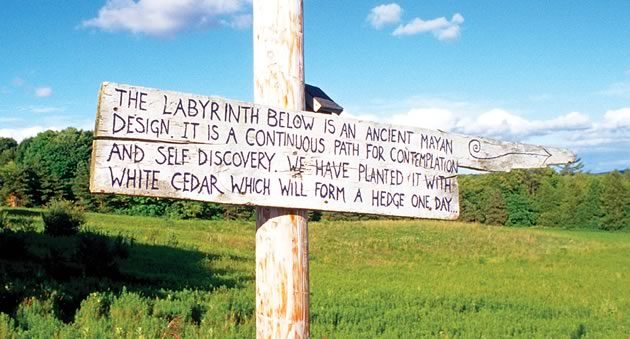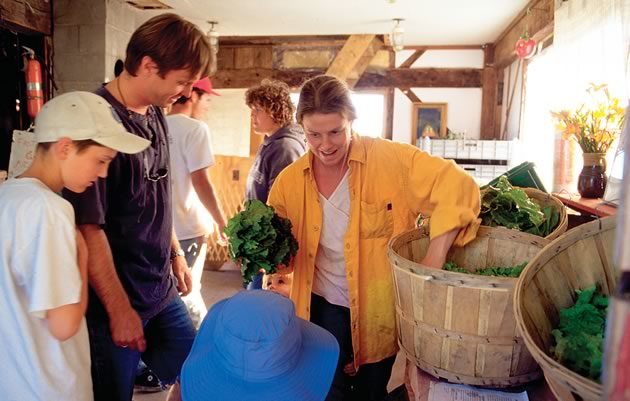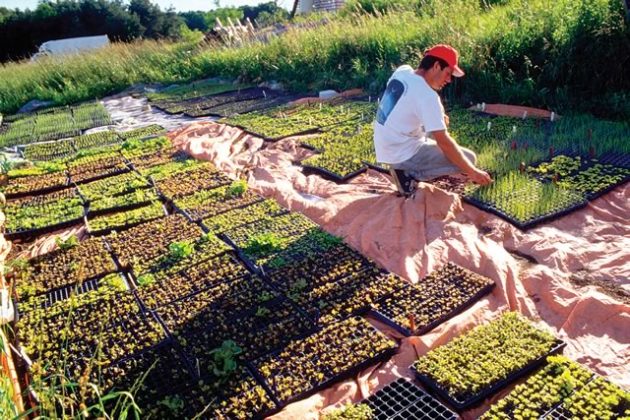Forever Everdale
In the hills of Erin, the idealism of the sixties morphs into practical solutions for sustainable living in the new century.
It has Canada’s smallest schoolroom and largest schoolyard, and that’s the point. Nestled in the hills of Erin, Everdale has been the scene of leading-edge experiments in visionary education – that’s education, not schooling – for nearly 40 years.
Now in its third incarnation, as Everdale Environmental Learning Centre, it offers hands-on education in sustainable living for students of all ages. A program of intensive workshops are designed for people who want to practice a new skill with a trained instructor before they actually try it on their own in their own place.
Workshops include such topics as straw bale home construction, solar power, herb identification, and wind power generation, among others.
In the 1960s, locals from nearby Hillsburgh called Everdale the “funny farm.” The 50-acre site had originally been Everdall’s horse farm. “We changed the name to make it sound more romantic,” says Everdale co-founder Bob Davis.
The first Everdale was conceived as a “free school,” modelled after A.S. Neill’s legendary free school in England. The first issue of This Magazine Is About Schools, the Bible of alternative educators around the world throughout the 1970s, was collated at Everdale.
By the mid-1970s, though, the free school had folded, and Everdale tried to find its way as a commune, first for former teaching staff, then for a variety of dreamers who could never quite make a go of it. For a long period, all it had going for it were a cluster of dishevelled buildings and a piece of paper that granted it an educational charter.
Since the mid-1990s, however, Everdale has re-emerged with a strong new commitment, a place where the nitty-gritty of green technologies and lifestyles is practiced and taught.
Comparisons with the old days of the youthful 1960s are inevitable. We will “work together in an egalitarian, questing spirit in the best traditions of Everdale School,” says the present-day Learning Centre’s statement of goals and objectives.
“It’s funny,” says Wally Seccombe, a man with boyish enthusiasm who has been at the helm of the Learning Centre’s shift to hands-on environmentalism. “We’ve come 360 degrees back to our hippie roots.”
It’s easy, even fun, to liken the counterculture of today to that of the 1960s, a decade often romanticized in the memories of its generation. But a few things have happened since the big chill, and some of them are pretty cool. There are some common threads with the past, but they are fairly subtle.
Take the case of Ruth Shamai, an Everdale alumna of the 1967 to 1969 years. After the last Everdale commune collapsed, she spent a lot of time during the 1990s looking for a successor. “We had a place without a vision and we needed someone with a vision but no place, until we found Wally,” she says.
In many ways, Ruth is the quintessential Everdale grad. She heads her own company, Ruth’s Hemp Foods, which sells a line of healthy hemp snacks – chips and energy bars, not brownies – and she’s an adviser to the North America-wide Hemp Industries Association.
What could be more sixties-retro than a company selling hemp? But hemp is now about “rope, not dope,” and Canada’s newly legal hemp industry converts hemp seeds and stalks into hundreds of useful products for food, fibre and fuel. Because hemp is an annual crop that can be grown without the use of pesticides, its many products are an environmentally friendly alternative to those that require logging, the use of fossil fuels or the manufacture of plastics. The new hemp industry is only one of many technical possibilities that the sixties generation didn’t even imagine.
It is precisely the development of practical technologies and materials during the past two decades that allows today’s Everdale to accept a mission to go where the counterculture of the sixties has never gone before. Things that were once vaguely dreamed of can now be done. And therein lies the big difference between then and now.
For Ruth Shamai and her peers, the common thread with the past is not tie-dye but something less tangible. Ruth credits her success as a green entrepreneur, and her ability to testify before scores of business, scientific and political groups, to the main thing she learned at Everdale, despite having skipped quite a few classes.
“Everdale empowered me,” she says, “helped me believe that if I feel like doing something, I can do it.” That accounts for the mantra she repeats before delivering a major power presentation: “I’m an Everdalian.”
That can-do approach lives on at today’s Everdale. As chair of the Learning Centre’s new board, Wally Seccombe continues to steer some of Everdale’s programs in the direction of troubled youth. He was a street worker for the YMCA and the Addiction Research Foundation during much of the 1960s and 1970s, headed up paramedic teams that talked down kids on bad trips at rock festivals, and wrote ARF’s first guide for hospital emergency wards dealing with tripped-out youth. He still enjoys working with youth, but now as a “land worker,” not a street worker.

The first rows of commercial garlic at the new Everdale were planted by squeegee youth on a day’s excursion from the streets of Toronto. “They totally fell in love with the place,” says Wally. These kids come from a “rip or be ripped environment,” he says, hanging out in malls or shopping avenues where they can see all the consumer goods but can’t touch.
“Getting out of the money economy and working with their hands, this is a transformative experience for some of them,” he says. “There are no angles, no shortcuts, and they can see the rewards in non-monetary terms, starting things to grow, or the incredible way food tastes after a hard day’s work.”
The value of the lesson isn’t limited to street youth. Everdale also offers a series of “Food for Thought” workshops aimed at elementary and secondary schools in the area and linked to the province’s core curriculum requirements. The pilot course, presented in 2000, was developed and tested in collaboration with the Ontario Institute for Studies in Education. This year the program will offer four workshops, on organic gardening, art and the environment, renewable energy, and water.
“It’s amazing to see the changed expressions on kids’ faces by the end of the day,” says program co-ordinator, Karen Campbell. They go through the first hour of instruction with a nonchalant look on their faces, she says, but after half a day of putting their shoulders to the wheel, “they’re all saying, ‘Hey, this is cool, I’m going to try this again.’”
For all workshop participants, youth and adult, Everdale’s goal is to “to link inspiration and competence,” says Wally. “We hope we can inspire people to see better alternatives, but we want inspired people to be competent. Then they can make a difference.”
That first visit by Toronto street kids in 1997 also transformed Everdale’s three new staff, Gavin Dandy, Karen Campbell, and Lynn Bishop. They were hired because of their experience as organic market gardeners, and they hired on partly because they couldn’t afford their own land to farm. For them, the squeegee kids cleared the window to see a new opportunity.
“Those same kids who got off the bus all grumpy, by the end of the day, they were beaming like five year olds,” says Gavin. “That’s when we suddenly realized that this was a special place and a great educational thing to offer people. That was the real beginning for us.”
Gavin, Karen and Lynn now spend most of their summer as market gardeners on four of Everdale’s 50 acres. It’s a serious business that gives them the experience to teach through spring and fall.
The market garden supplies a number of organic wholesalers out of Toronto and Orangeville, and about 43 households in Hillsburgh and Erin. The latter group are part of what’s called a CSA, or Community-Supported Agriculture, one of the fastest-growing trends in organic retailing.

Everdale’s organic market garden supplies a number of organic wholesalers in
Toronto and Orangeville, as well as about 43 households in Erin and Hillsburgh. Photo by Vivian Kellner.
Everdale’s CSA members pay about $580 at the beginning of the season as an advance to cover the costs of seeds, equipment, and early labour. In return, members will receive a weekly box of fresh-picked organic vegetables for about 19 weeks during the summer and fall. The arrangement also gives them a close-up relationship with their food and food producers.
The market garden also fulfills an educational role. Everdale hires three apprentices each year and provides them with a gruelling experience in organic growing and marketing techniques. This year, for the first time, Everdale has teamed up with six other organic growers in the area, so that all their apprentices can gain a comprehensive organic experience, working with livestock, horse-drawn ploughs, the whole nine yards.
With its new sense of purpose, Everdale itself has grown rapidly, the same way nature always grows back after periods of great disturbance and change, with lots of colourful and hardy wild flowers and few mature species.
That fits with Wally’s seat-of-the-heart development strategy. Formerly a devotee of the “what is to be done” school of social and political change, he now believes in following the passions.
The old left from before the 1960s and the new left that came out of that decade both started with objectives, figured out what had to be done, then guilted and cajoled people into doing it, Wally says. Conventional schools do the same: figure out what skills students need to learn and drill them in. “I’ve learned to start with people’s passions and educate them,” he says.
Overlooking one of the two market gardens is an herb garden managed by Guelph herbalist Janice Canning. Jerry-built with a mixture of Celtic, Native and feng shui designs, it features 36 beds of plants that are used in workshops on making herbal tinctures. “I just want to let people know they already have a wealth of healthy plants in their own backyard,” Janice says after a workshop on kitchen remedies.
Janice was given rights to grow and teach on a quarter-acre hilltop at Everdale last year. “Here it is, what do you want to do with it,” she recalls being told.
“This is part of the magic of Everdale,” says Wally Seccombe. “If you want to offer something like this, you either do it yourself and go out and raise a lot of money, or you invite people like Janice.” He’s issued the same challenge to Bob Wildfong of Seeds of Diversity, who will be starting a new garden to raise rare and endangered food seeds this summer.
“Look at those two examples of enrichment,” says Wally. “All we said was: there’s a field, go to it.”
This may be the new millennium’s version of “do your own thing,” spiced differently from the sixties’ version. Like a sweet onion, “do your own thing” has many possible layers of meanings. It can mean goofing off, defying authority and following your inner passions, or it can mean working your buns off so you can take responsibility for yourself, defying authority, and following your inner passions.
It is the second version of doing your own thing that fascinates Wally, who teaches sociology part-time at the Ontario Institute for Studies in Education. He gained an international reputation for an article called “The Housewife and her Labour Under Capitalism” in the 1973 New Left Review. In it, he argued that the unpaid labour of housewives was what made capitalism tick. Without housewives to cook the meals, clean the house, make the beds and raise the young, the profit-driven economy would be nowhere, he argued. So when the environmental movement came along, he said “Right! What else is under that economy, doing work for nothing? Nature!”
Wally sees Everdale as a place where people can learn to meet their own needs with their own labour. By learning to do their own thing, people can survive even if they lose their jobs or have their incomes cut, he says. And they can produce things in the most environmentally friendly way at the same time.
Everdale’s rolling hills have watched over all the changes in vision and theory, providing the perfect place to get lost in your thoughts or to find yourself. Not much good for mechanized farming or suburban tract development, the hills have protected Everdale. They also provide scores of microclimates, hideaways and niche opportunities, which flatlands just can’t do.
The hills face south, giving direct sun to a variety of crops that need more light and heat than normal for this area. The slopes beside one of the main gardens, used for pasture in the Everdall days, are being returned slowly to forest and wildlife. The hills below the main gardens and buildings fall into a marsh, home to a variety of birds and mammals. In the near future, nature trails will be built through the meadow and along the marsh, a reminder that countryside can do more than produce food, it can nourish all our senses.

Members of the Everdale CSA enjoy a weekly supply of fresh organic vegetables. Photo by Vivian Kellner.
Tucked away behind a hill, 500 yards from the main buildings, is an outcrop of secluded cabins made from plastered straw bales, a relatively easy, low-cost and environmentally friendly form of construction. The cabins will provide bunks for the non-campers among the people taking part in multi-day workshops in the future.
The main buildings careen along a gentle slope. Two have seen better days. The old farmhouse is beyond repair, due to neglect suffered during the 1970s and 1980s. It will be sold for salvage. The old barn faces a similar fate. The staff lives in adjoining cabins hidden behind clumps of lilac. Further down, another cabin is rented to Wally Seccombe and Bob Davis, who now teaches in the education department of York University. Below that is a meetinghouse, beneficiary of most of the renovations undertaken since Everdale’s rebirth. Beside that is a new greenhouse and a new solar water heater. Among other duties, the heater provides hot outdoor showers for guests and farmhands.
Buildings and sites can learn and adjust, just like people, according to prominent architecture critic Stewart Brand, author of How Buildings Learn and founder of the 1960s’ classic series of Whole Earth Catalogues. He is a big fan of open and ramshackle structures. The more modest, temporary and box-like the building, he argues, the more comfortable people feel changing it, the more special places people create, the more the building oozes personality, and the more people are encouraged to let down their hair and think outside the box. New ideas, new economic activities and new sources of power come from such buildings, he says.
At Everdale, it is hoped the buildings will evolve just that way, augmented by such new offerings as the butterfly garden, meditation centre, windmill and nature walks. Martin Liefheber, one of Toronto’s most prominent green architects, has offered his design services. And staff members are excited by the prospect of planning their growth. “We’re finally at the point where we can think beyond tomorrow,” says Gavin Dandy.
The times, they are a-changing.






